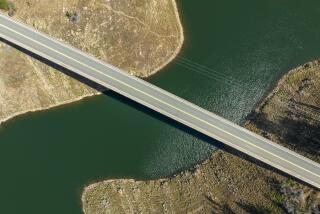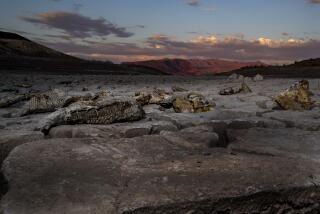A Humbling Lesson From Two Droughts
- Share via
The Southern California sky was trellised Thursday with thin, gray clouds--precursors of a Pacific storm that was expected to reach the coast later in the night. The front would be the second in a week, and for now anyway the meteorology is right for even more storms to follow. “The welcome mat is out,” is how one forecaster described things.
Let’s hope. A few major storms in rapid succession and we would witness a true spectacle: houses cascading down hillsides, rivers breaching their banks, reservoirs overflowing--and state water officials chanting, on every channel, “The drought is not over. The drought is not over.”
Nature can finish off a drought in days, but it takes the state of California a bit longer. At the end of the last big drought, in the mid-1970s, it was remarkable how state officials kept refusing to sanction the obvious. One Pacific storm after another had surged across the state. Mountains sagged under all the snow. City streets ran like streams. It was so wet the duck-hunting season was canceled. Still, the watercrats stuck to their story.
“The drought is a long way from being over,” they would tell reporters day after rainy day. “We’re not out of the woods yet.” There always seemed to be something wrong with the latest downpour. It didn’t fall in the right place. The snow was too dry, the rain was too warm, or even too moist. This instinct for wariness is best reflected in a Times headline from that winter: “4-Day Rains May Prolong State Drought.”
When the end finally came, it was anti-climactic and comic. One rainy Monday morning in mid-Janaury, officials who had toiled for two years in the state Drought Information Center discovered a new sign marking their door: They were now employees of the state Flood Control Center. The drought, they finally begrudged, was over--”for this year.”
The watercrats had their reasons, good and bad, and I suspect the same thinking still applies. For one thing, government tends to distrust the governed, and it appears there is some fear that to call a drought over is to declare open season on water-guzzling. This is a bum rap, because in both the last drought and the present one, Californians have answered the call to conserve beyond all expectations.
Semantics also come into play. The state, unlike most of us, does not define a drought simply as a long dry spell. It defines a drought as the conditions created by a long dry spell. By this definition, a drought is not over until reservoirs are replenished, mountains are overloaded with snow, underground water tables are recharged--requirements which, in the current case, couldn’t be met even with a full year of normal rainfall. “We like to have that bird in the hand,” said Bill Helms, a state Department of Water Resources veteran.
Finally, there is an understandable instinct toward caution when it comes to predicting anything about California’s winter weather. “We hope for the best, and plan for the worst,” Helms said.
Anyone who thought he understood state climate patterns was humbled by these two droughts. No longer does anyone believe, as we were always taught, that the weather runs on three-year cycles or, as the pioneers believed, that rain would always follow the plow.
All we know for certain is that, for some reason, high pressure systems can settle over the state and block the passage of winter storms. The television weathermeisters call this the “storm door,” and during a drought it stays closed. Right now, today, the door is open. Should it stay open long enough to allow in, quickly, three or four whopper storms, things would happen fast: Once again, water officials would struggle to convince a submerging state that, even though it appears the drought is over, it really isn’t, because . . . glub, glub, glub.
It’s funny though, this time around the question of whether the drought is officially over seems far less important. In the last drought, there was a sense that once it was over, it was over--a passing quirk. Everything was back to normal. Now that California has been burned twice in two decades, no one can pretend to know what normal weather is anymore.
The scientists are consulting tree rings and ocean temperatures, but they don’t know how much rain to expect in the next year, or next decade, or next century. The farmers don’t know, even as they decide what kind of crops to plant. The city planners, poring over blueprints of proposed housing developments, they don’t know, either.
The implication of this mutual uncertainty seems obvious. If we can’t count on rain, we had better plan on drought. Certain crops might need to be abandoned, subdivisions left unbuilt, conservation tactics made permanent. Like the watercrats, we might look foolish in wet years, but at least we’d be set for dry ones.
More to Read
Sign up for Essential California
The most important California stories and recommendations in your inbox every morning.
You may occasionally receive promotional content from the Los Angeles Times.














